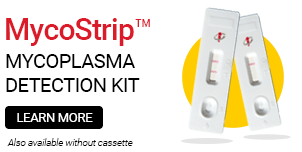Poly(I:C) (HMW) VacciGrade™
| Product | Unit size | Cat. code | Docs. | Qty. | Price | |
|---|---|---|---|---|---|---|
|
Poly(I:C) (HMW) VacciGrade™ Polyinosine-polycytidylic acid -TLR3 agonist |
Show product |
10 mg |
vac-pic
|
|
TLR3 agonist - Polyinosine-polycytidylic acid | Th1 response
Poly(I:C) HMW VacciGrade™ is a synthetic analog of double-stranded RNA (dsRNA) and a strong inducer of type I IFNs.
Depending on its location in the cell, poly(I:C) can activate innate immunity through distinct PRR pathways: endosomal poly(I:C) activates TLR3, whereas cytosolic poly(I:C) activates RIG-I/MDA-5 and PKR.
Triggering the TLR3 pathway induces IL-12 and type I IFNs, whereas stimulation of RIG-I/MDA-5 enhances the production of type I IFNs. Poly(I:C) promotes Th1-dominant immunity through its induction of IL-12 and type I IFNs.
Poly(I:C) HMW VacciGrade™ is a high-quality pre-clinical grade.
Poly(I:C) HMW VacciGrade™ is for research use only, and not for human or veterinary use.
Specifications
Description: TLR3, RIG-I/MDA5 agonist VacciGrade™
Polarization of adaptive immune response: Th1 response
CAS number: 31852-29-6
Solubility: 1 mg/ml in physiological water (NaCl 0.9%) heated for 10 minutes at 65 - 70°C
Working concentration: 10 - 100 μg/mouse
Quality control:
- Sterility guaranteed
- The absence of bacterial contamination (lipoproteins & endotoxins) has been confirmed using HEK-Blue-Lucia™ hTLR2 and HEK-Blue-Lucia™ mTLR4 cells
- Endotoxin level < 1 EU/mg (measurement by kinetic chromogenic LAL assay)
Contents
- 10 mg of lyophilized Poly(I:C) HMW VacciGrade™
- 10 ml sterile endotoxin-free physiological water (NaCl 0.9%)
Note: This product is dispensed by weight of dry material. This weight includes polymer, residual salt, and residual water. The content of polymer may vary from lot to lot.
![]() Poly(I:C) HMW VacciGrade™ is shipped at room temperature.
Poly(I:C) HMW VacciGrade™ is shipped at room temperature.
![]() Upon receipt, store at 4°C.
Upon receipt, store at 4°C.
Back to the top
VacciGrade™
VacciGrade™ is a high-quality pre-clinical grade. VacciGrade™ products are filter-sterilized (0.2 µm) and filled under strict aseptic conditions in a clean room*. The absence of bacterial contamination is assessed by a sterility test using a pharmacopeia-derived assay. The level of bacterial contaminants (endotoxins and lipoproteins) in each lot is verified using a LAL assay and/or a TLR2 and TLR4 reporter assay.
*Except for LPS VacciGrade™, which is prepared in a laminar flow hood dedicated to LPS.
Details
Polyinosinic-polycytidylic acid (poly(I:C)) is a synthetic analog of double-stranded RNA (dsRNA), a molecular pattern associated with viral infections.
Poly(I:C) can activate the immune response through two distinct pathogen recognition receptors (PRRs) [1]. Endosomal poly(I:C) activates TLR3 while cytosolic poly(I:C) activates RIG-I/MDA-5.
Triggering the TLR3 pathway induces IL-12 and type I IFNs production, and improves MHC class II expression and cross-presentation of antigen [1].
Stimulation of MDA-5 enhances the production of type I IFNs that play a critical role in enhancing T and B cell immunity [1]. Poly(I:C) promotes Th1 (cellular) biased immunity through its induction of IL-12 and type I IFNs [1].
Poly(I:C) has been tested as an adjuvant in numerous animal models [2-9]. Promising results have been obtained using poly(I:C) as an adjuvant in flu vaccine delivered intranasally to mice [2].
Poly(I:C) has also been shown to enhance the efficacy of peptide-based cancer vaccines by promoting tumor-specific T-cell responses in mice [3-6].
Immunization of mice with poly(I:C) resulted in a strong Th1 response [7] and high levels of serum type I IFN [8].
1. Coffman R.L. et al., 2010. Vaccine adjuvants: Putting innate immunity to work. Immunity 33(4):492-503.
2. Ichinohe T. et al., 2005. Synthetic double-stranded RNA poly(I:C) combined with mucosal vaccine protects against influenza virus infection. J Virol. 79(5):2910–2919.
3. Pulko V. et al., 2009. TLR3-stimulated dendritic cells upregulate B7-H1expression and influence the magnitude of CD8 T cell responses to tumor vaccination. J Immunol 183(6):3634–3641.
4. Currie A.J. et al., 2008. Targeting the effector site with IFN-alpha beta-inducing TLR ligands reactivates tumor-resident CD8 T cell responses to eradicate established solid tumors. J Immunol 180(3):1535–1544.
5. Salem M.L. et al., 2005. Defining the antigen-specific T-cell response to vaccination and poly(I:C)/TLR3 signaling: evidence of enhanced primary and memory CD8 T-cell responses and antitumor immunity. J Immunother 28(3):220–228.
6. Celis E. 2007. Toll-like receptor ligands energize peptide vaccines through multiple paths. Cancer Res. 67(17):7945–7947.
7. Fransen F. et al., 2007. Agonists of Toll-like receptors 3, 4, 7, and 9 are candidates for use as adjuvants in an outer membrane vaccine against Neisseria meningitidis serogroup B. Infect Immun 75: 5939-46.
8. Longhi M.P. et al., 2009. Dendritic cells require a systemic type I interferon response to mature and induce CD4+ Th1 immunity with poly IC as adjuvant. J Exp Med 206: 1589-602.
9. Stahl-Hennig C. et al., 2009. Synthetic double-stranded RNAs are adjuvants for the induction of T helper 1 and humoral immune responses to human papillomavirus in rhesus macaques. PLoS Pathog 5:e1000373.




